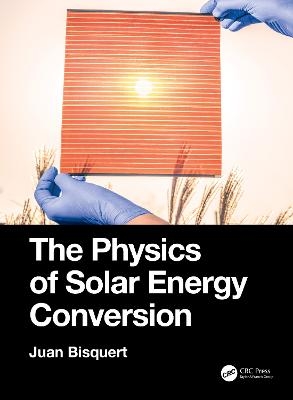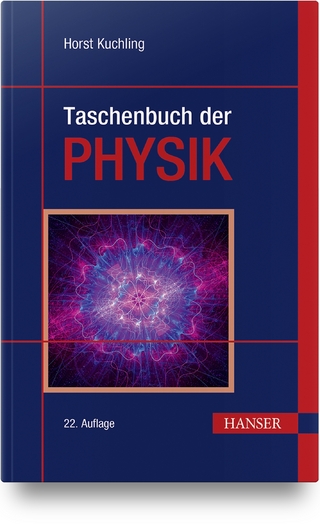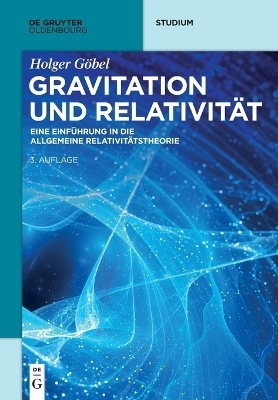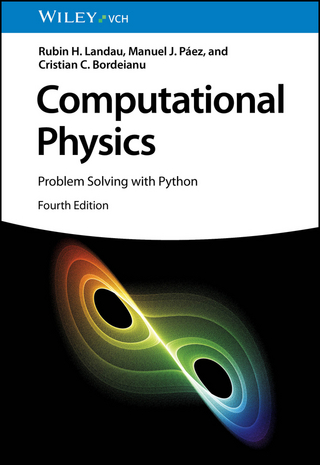
The Physics of Solar Energy Conversion
CRC Press (Verlag)
978-0-367-49602-9 (ISBN)
- Titel z.Zt. nicht lieferbar
- Versandkostenfrei innerhalb Deutschlands
- Auch auf Rechnung
- Verfügbarkeit in der Filiale vor Ort prüfen
- Artikel merken
Research on advanced energy conversion devices such as solar cells has intensified in the last two decades. A broad landscape of candidate materials and devices were discovered and systematically studied for effective solar energy conversion and utilization. New concepts have emerged forming a rather powerful picture embracing the mechanisms and limitation to efficiencies of different types of devices. The Physics of Solar Energy Conversion introduces the main physico-chemical principles that govern the operation of energy devices for energy conversion and storage, with a detailed view of the principles of solar energy conversion using advanced materials.
Key Features include:
Highlights recent rapid advances with the discovery of perovskite solar cells and their development.
Analyzes the properties of organic solar cells, lithium ion batteries, light emitting diodes and the semiconductor materials for hydrogen production by water splitting.
Embraces concepts from nanostructured and highly disordered materials to lead halide perovskite solar cells
Takes a broad perspective and comprehensively addresses the fundamentals so that the reader can apply these and assess future developments and technologies in the field.
Introduces basic techniques and methods for understanding the materials and interfaces that compose operative energy devices such as solar cells and solar fuel converters.
Juan Bisquert is a professor of applied physics at the Universitat Jaume I de Castello and the funding director of the Institute of Advanced Materials at UJI. He earned an MSc in physics in 1985 and a PhD from the Universitat de Valencia in 1992. The research work is in perovskite solar cells, semiconductor optoelectronics, mixed ionicelectronic conductors, and solar fuel converters based on visible light and semiconductors for water splitting and CO2 reduction. His most well-known work is about the mechanisms governing the operation of nanostructured and solution-processed thin film solar cells. He has developed insights in the electronic processes in hybrid organic–inorganic solar cells, combining the novel theory of semiconductor nanostructures, photoelectrochemistry, and systematic experimental demonstration. His contributions produced a broad range of concepts and characterization methods to analyze the operation of photovoltaic and optoelectronic devices. He is a senior editor of the Journal of Physical Chemistry Letters. He has been distinguished several times in the list of ISI Highly Cited Researchers. Bisquert created nanoGe Conferences and is the president of the Fundacio Scito. He wrote a novel of speculative fiction, The Canamel Conjecture.
Contents
Preface........................................................................................................................................................................xv
Acknowledgments....................................................................................................................................................xvii
Author.......................................................................................................................................................................xix
Chapter 1 Introduction to Energy Devices...............................................................................................................1
References...............................................................................................................................................9
PART I Equilibrium Concepts and Kinetics
Chapter 2 Electrostatic and Thermodynamic Potentials of Electrons in Materials...............................................13
2.1 Electrostatic Potential..................................................................................................................13
2.2 Energies of Free Electrons and Holes.......................................................................................... 14
2.3 Potential Energy of the Electrons in the Semiconductor............................................................. 17
2.4 The Vacuum Level....................................................................................................................... 17
2.5 The Fermi Level and the Work Function....................................................................................20
2.6 The Chemical Potential of Electrons........................................................................................... 21
2.7 Potential Step of a Dipole Layer or a Double Layer....................................................................23
2.8 Origin of Surface Dipoles............................................................................................................24
2.9 The Volta Potential......................................................................................................................25
2.10 Equalization of Fermi Levels of Two Electronic Conductors in Contact....................................27
2.11 Equilibration of Metal Junctions and the Contact Potential Difference......................................28
2.12 Equilibrium across the Semiconductor Junction.........................................................................29
General References............................................................................................................................... 31
References............................................................................................................................................. 31
Chapter 3 Voltage, Capacitors, and Batteries.........................................................................................................33
3.1 The Voltage in the Device...........................................................................................................33
3.2 Anode and Cathode.....................................................................................................................34
3.3 Applied Voltage and Potential Difference...................................................................................35
3.4 The Capacitor..............................................................................................................................37
3.5 Measurement of the Capacitance.................................................................................................38
3.6 Energy Storage in the Capacitor..................................................................................................40
3.7 Electrochemical Systems: Structure of the Metal/Solution Interface..........................................40
3.8 Electrode Potential and Reference Electrodes.............................................................................42
3.9 Redox Potential in Electrochemical Cells...................................................................................44
3.10 Electrochemical and Physical Scales of Electron Energy in Material Systems..........................45
3.11 Changes of Electrolyte Levels with pH.......................................................................................46
3.12 Principles of Electrochemical Batteries.......................................................................................47
3.13 Capacity and Energy Content......................................................................................................50
3.14 Practical Electrochemical Batteries............................................................................................. 51
3.14.1 Zinc-Silver Battery.......................................................................................................... 51
3.14.2 Sodium-Sulfur Battery....................................................................................................52
3.15 Li-Ion Battery.............................................................................................................................. 53
General References...............................................................................................................................57
References.............................................................................................................................................57
Chapter 4 Work Functions and Injection Barriers.................................................................................................59
4.1 Injection to Vacuum in Thermionic Emission.............................................................................59
4.2 Richardson–Dushman Equation..................................................................................................60
4.3 Kelvin Probe Method.................................................................................................................. 61
4.4 Photoelectron Emission Spectroscopy.........................................................................................63
4.5 Injection Barriers.........................................................................................................................66
4.6 Pinning of the Fermi Level and Charge-Neutrality Level...........................................................69
General References...............................................................................................................................73
References.............................................................................................................................................73
Chapter 5 Thermal Distribution of Electrons, Holes, and Ions in Solids............................................................... 75
5.1 Equilibration of the Electrochemical Potential of Electrons....................................................... 75
5.2 Configurational Entropy of Weakly Interacting Particles...........................................................76
5.3 Equilibrium Occupancy of Conduction Band and Valence Band States.....................................76
5.4 Equilibrium Fermi Level and the Carrier Number in Semiconductors.......................................79
5.5 Transparent Conducting Oxides.................................................................................................. 81
5.6 Hot Electrons...............................................................................................................................82
5.7 Screening.....................................................................................................................................84
5.8 The Rectifier at Forward and Reverse Voltage............................................................................85
5.9 Semiconductor Devices as Thermal Machines that Realize Useful Work..................................88
5.10 Cell Potential in the Lithium Ion Battery....................................................................................90
5.11 Insertion of Ions: The Lattice Gas Model....................................................................................94
General References...............................................................................................................................98
References.............................................................................................................................................98
Chapter 6 Interfacial Kinetics and Hopping Transitions...................................................................................... 101
6.1 Principle of Detailed Balance.................................................................................................... 101
6.2 Form of the Transition Rates.....................................................................................................104
6.3 Kinetics of Localized States: Shockley-Read-Hall Recombination Model...............................106
6.4 Reorganization Effects in Charge Transfer: The Marcus Model............................................... 107
6.5 Polaron Hopping........................................................................................................................ 112
6.6 Rate of Electrode Reaction: Butler-Volmer Equation................................................................ 115
6.6.1 Availability of Electronic Species................................................................................. 116
6.6.2 Availability of Redox Species........................................................................................ 116
6.6.3 The Kinetic Constant for Charge Transfer.................................................................... 117
6.7 Electron Transfer at Metal-Semiconductor Contact..................................................................120
6.8 Electron Transfer at the Semiconductor/Electrolyte Interface.................................................. 121
General References.............................................................................................................................126
References...........................................................................................................................................127
Chapter 7 The Chemical Capacitance.................................................................................................................. 131
7.1 Carrier Accumulation and Energy Storage in the Chemical Capacitance................................. 131
7.2 Localized Electronic States in Disordered Materials and Surface States................................. 133
7.3 Chemical Capacitance of a Single State.................................................................................... 135
7.4 Chemical Capacitance of a Broad DOS.................................................................................... 136
7.5 Filling a DOS with Carriers: The Voltage and the Conductivity.............................................. 138
7.6 Chemical Capacitance of Li Intercalation Materials................................................................. 139
7.7 Chemical Capacitance of Graphene.......................................................................................... 140
General References............................................................................................................................. 142
References........................................................................................................................................... 143
Chapter 8 The Density of States in Disordered Inorganic and Organic Conductors........................................... 145
8.1 Capacitive and Reactive Current in Cyclic Voltammetry.......................................................... 145
8.2 Kinetic Effects in CV Response................................................................................................ 149
8.3 The Exponential DOS in Amorphous Semiconductors.............................................................150
8.4 The Exponential DOS in Nanocrystalline Metal Oxides.......................................................... 152
8.5 Basic Properties of Organic Layers........................................................................................... 156
8.6 The Gaussian DOS.................................................................................................................... 160
General References............................................................................................................................. 162
References........................................................................................................................................... 163
Chapter 9 Planar and Nanostructured Semiconductor Junctions......................................................................... 167
9.1 Structure of the Schottky Barrier at a Metal/Semiconductor Contacts..................................... 167
9.2 Changes of the Schottky Barrier by the Applied Voltage.......................................................... 168
9.3 Properties of the Planar Depletion Layer.................................................................................. 170
9.4 Mott–Schottky Plots.................................................................................................................. 171
9.5 Capacitance Response of Defect Levels and Surface States..................................................... 172
9.6 Semiconductor Electrodes and the Flatband Potential.............................................................. 173
9.7 Changes of Redox Level and Band Unpinning.......................................................................... 176
9.8 Inversion and Accumulation Layer............................................................................................ 180
9.9 Heterojunctions.......................................................................................................................... 181
9.10 Effect of Voltage on Highly Doped Nanocrystalline Semiconductors...................................... 183
9.11 Homogeneous Carrier Accumulation in Low-Doped Nanocrystalline Semiconductors........... 188
General References............................................................................................................................. 192
References........................................................................................................................................... 192
PART II Foundations of Carrier Transport
Chapter 10 Carrier Injection and Drift Transport.................................................................................................. 197
10.1 Transport by Drift in the Electrical Field.................................................................................. 197
10.2 Injection at Contacts.................................................................................................................. 198
10.3 The Metal-Insulator-Metal Model.............................................................................................202
10.4 The Time-of-Flight Method......................................................................................................205
General References.............................................................................................................................206
References...........................................................................................................................................206
Chapter 11 Diffusion Transport.............................................................................................................................209
11.1 Diffusion in the Random Walk Model......................................................................................209
11.2 Macroscopic Diffusion Equation............................................................................................... 211
11.3 The Diffusion Length................................................................................................................ 212
11.4 Chemical Diffusion Coefficient and the Thermodynamic Factor............................................. 213
General References............................................................................................................................. 215
References........................................................................................................................................... 215
Chapter 12 Drift-Diffusion Transport.................................................................................................................... 217
12.1 General Transport Equation in Terms of Electrochemical Potential......................................... 217
12.2 The Transport Resistance.......................................................................................................... 217
12.3 The Einstein Relation................................................................................................................ 219
12.4 Drift-Diffusion Equations..........................................................................................................220
12.5 Ambipolar Diffusion Transport................................................................................................221
12.6 Relaxation of Injected Charge..................................................................................................222
12.7 Transient Current in Insulator Layers.......................................................................................223
12.8 Modeling Transport Problems..................................................................................................224
General References.............................................................................................................................227
References...........................................................................................................................................227
Chapter 13 Transport in Disordered Media...........................................................................................................229
13.1 Multiple Trapping and Hopping Transport...............................................................................229
13.2 Transport by Hopping in a Single Level...................................................................................231
13.3 Trapping Factors in the Kinetic Constants...............................................................................233
13.4 Two-Level (Single-Trap) Model................................................................................................235
13.5 Multiple Trapping in Exponential DOS....................................................................................237
13.6 Activated Transport in a Gaussian DOS...................................................................................237
13.7 Multiple Trapping in the Time Domain....................................................................................239
13.8 Hopping Conductivity...............................................................................................................241
13.9 The Transport Energy...............................................................................................................242
13.10 Variable Range Hopping...........................................................................................................243
General References.............................................................................................................................245
References...........................................................................................................................................245
Chapter 14 Thin Film Transistors..........................................................................................................................249
14.1 Organic Thin Film Transistors.................................................................................................249
14.2 Carrier Density in the Channel.................................................................................................250
14.3 Determination of the DOS in Thin Film Transistor Configuration..........................................252
14.4 Current-Voltage Characteristics................................................................................................255
14.5 The Mobility in Disordered Semiconductors............................................................................257
14.6 Electrochemical Transistor.......................................................................................................258
General References.............................................................................................................................259
References...........................................................................................................................................259
Chapter 15 Space-Charge-Limited Transport........................................................................................................263
15.1 Space-Charge-Limited Current................................................................................................263
15.2 Injected Carrier Capacitance in SCLC.....................................................................................265
15.3 Space Charge in Double Injection............................................................................................267
General References.............................................................................................................................269
References...........................................................................................................................................269
Chapter 16 Impedance and Capacitance Spectroscopies....................................................................................... 271
16.1 Frequency Domain Measurements...........................................................................................271
16.2 Dielectric Relaxation Functions................................................................................................272
16.3 Resistance and Capacitance in Equivalent Circuit Models.......................................................274
16.4 Relaxation in Time Domain......................................................................................................279
16.5 Universal Properties of the Frequency-Dependent Conductivity..............................................281
16.6 Electrode Polarization...............................................................................................................283
General References.............................................................................................................................284
References...........................................................................................................................................284
PART III Radiation, Light, and Semiconductors
Chapter 17 Blackbody Radiation and Light...........................................................................................................289
17.1 Photons and Light......................................................................................................................289
17.2 Spread and Direction of Radiation............................................................................................289
17.3 Color and Photometry................................................................................................................ 291
17.4 Blackbody Radiation.................................................................................................................293
17.5 The Planck Spectrum................................................................................................................294
17.6 The Energy Density of The Distribution of Photons in Blackbody Radiation..........................295
17.7 The Photon and Energy Fluxes in Blackbody Radiation...........................................................297
17.8 The Solar Spectrum...................................................................................................................299
General References.............................................................................................................................302
References...........................................................................................................................................302
Chapter 18 Light Absorption, Carrier Recombination, and Luminescence...........................................................305
18.1 Absorption of Incident Radiation..............................................................................................305
18.2 Luminescence and Energy Transfer..........................................................................................307
18.3 The Quantum Efficiency........................................................................................................... 310
18.4 The Recombination of Carriers in Semiconductors.................................................................. 311
18.5 Recombination Lifetime............................................................................................................ 314
General References............................................................................................................................. 316
References........................................................................................................................................... 316
Chapter 19 Optical Transitions in Organic and Inorganic Semiconductors.......................................................... 319
19.1 Light Absorption in Inorganic Solids........................................................................................ 319
19.2 Free Carrier Phenomena............................................................................................................323
19.3 Excitons.....................................................................................................................................325
19.4 Quantum Dots...........................................................................................................................328
19.5 Organic Molecules and Materials..............................................................................................330
19.6 The CT Band in Organic Blends and Heterojunctions.............................................................. 333
General References............................................................................................................................. 336
References........................................................................................................................................... 336
PART IV Photovoltaic Principles and Solar Energy Conversion
Chapter 20 Fundamental Model of a Solar Cell....................................................................................................343
20.1 Majority Carrier Injection Mechanisms....................................................................................343
20.2 Majority Carrier Devices...........................................................................................................344
20.3 Minority Carrier Devices..........................................................................................................345
20.4 Fundamental Properties of a Solar Cell.....................................................................................346
20.5 Physical Properties of Selective Contacts in Solar Cells...........................................................348
General References............................................................................................................................. 351
References........................................................................................................................................... 351
Chapter 21 Recombination Current in the Semiconductor Diode......................................................................... 353
21.1 Dark Equilibrium of Absorption and Emission of Radiation.................................................... 353
21.2 Recombination Current............................................................................................................. 355
21.3 Dark Characteristics of Diode Equation.................................................................................... 356
21.4 Light-Emitting Diodes............................................................................................................... 357
21.5 Dye Sensitization and Molecular Diodes...................................................................................360
General References.............................................................................................................................363
References...........................................................................................................................................363
Chapter 22 Radiative Equilibrium in a Semiconductor.........................................................................................365
22.1 Utilization of Solar Photons......................................................................................................365
22.2 Fundamental Radiative Carrier Lifetime..................................................................................368
22.3 Radiative Emission of a Semiconductor Layer..........................................................................369
22.4 Photons at Nonzero Chemical Potential.................................................................................... 370
General References............................................................................................................................. 373
References........................................................................................................................................... 373
Chapter 23 Reciprocity Relations in Solar Cells and Fundamental Limits to the Photovoltage ........................... 375
23.1 The Reciprocity between LED and Photovoltaic Performance Parameters.............................. 375
23.2 Factors Determining the Photovoltage...................................................................................... 378
23.3 External Radiative Efficiency....................................................................................................382
23.4 Photon Recycling.......................................................................................................................383
23.5 Radiative Cooling in EL and Photoluminescence.....................................................................386
23.6 Reciprocity of Absorption and Emission in a CT Band............................................................387
General References............................................................................................................................. 391
References...........................................................................................................................................392
Chapter 24 Charge Separation and Material Limits to the Photovoltage...............................................................395
24.1 Light Absorption........................................................................................................................395
24.2 Charge Separation.....................................................................................................................395
24.3 Materials Limits to the Photovoltage.........................................................................................398
General References.............................................................................................................................403
References...........................................................................................................................................404
Chapter 25 Operation of Solar Cells and Fundamental Limits to Their Performance..........................................407
25.1 Current-Voltage Characteristics.................................................................................................407
25.2 Power Conversion Efficiency.....................................................................................................408
25.3 Analysis of FF........................................................................................................................... 410
25.4 Shockley–Queisser Efficiency Limits........................................................................................ 412
25.5 Practical Solar Cells Efficiency Limits...................................................................................... 413
General References............................................................................................................................. 419
References........................................................................................................................................... 419
Chapter 26 Charge Collection in Solar Cells......................................................................................................... 421
26.1 Introduction to Charge Collection Properties............................................................................ 421
26.2 Charge Collection Distance.......................................................................................................422
26.3 General Modeling Equations.....................................................................................................424
26.4 The Boundary Conditions.........................................................................................................425
26.4.1 Charge Extraction Boundary Condition........................................................................426
26.4.2 Blocking Boundary Condition.......................................................................................427
26.4.3 Generalized Boundary Conditions................................................................................428
26.5 A Photovoltaic Model with Diffusion and Recombination........................................................429
26.6 The Gärtner Model.................................................................................................................... 433
26.7 Diffusion-Recombination and Collection in the Space-Charge Region.................................... 435
26.8 Solar Cell Simulation................................................................................................................. 436
26.9 Classification of Solar Cells....................................................................................................... 437
26.10 Measuring and Reporting Solar Cell Efficiencies..................................................................... 439
General References.............................................................................................................................442
References...........................................................................................................................................442
Chapter 27 Spectral Harvesting and Photoelectrochemical Conversion................................................................445
27.1 Conversion of Photon Frequencies for Solar Energy Harvesting..............................................445
27.2 Tandem Solar Cells....................................................................................................................448
27.3 Solar Fuel Generation................................................................................................................450
General References.............................................................................................................................456
References...........................................................................................................................................456
Appendix................................................................................................................................................................. 459
Index........................................................................................................................................................................463
| Erscheinungsdatum | 29.07.2022 |
|---|---|
| Zusatzinfo | 11 Tables, black and white; 213 Illustrations, color; 269 Illustrations, black and white |
| Verlagsort | London |
| Sprache | englisch |
| Maße | 210 x 280 mm |
| Gewicht | 1340 g |
| Themenwelt | Naturwissenschaften ► Physik / Astronomie |
| Technik ► Elektrotechnik / Energietechnik | |
| Technik ► Maschinenbau | |
| ISBN-10 | 0-367-49602-X / 036749602X |
| ISBN-13 | 978-0-367-49602-9 / 9780367496029 |
| Zustand | Neuware |
| Haben Sie eine Frage zum Produkt? |
aus dem Bereich


